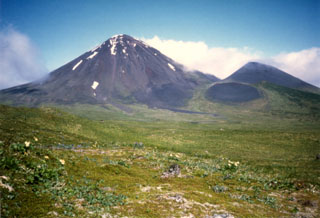Report on Semisopochnoi (United States) — 14 April-20 April 2021
Smithsonian Institution / US Geological Survey
Weekly Volcanic Activity Report, 14 April-20 April 2021
Managing Editor: Sally Sennert.
Please cite this report as:
Global Volcanism Program, 2021. Report on Semisopochnoi (United States) (Sennert, S, ed.). Weekly Volcanic Activity Report, 14 April-20 April 2021. Smithsonian Institution and US Geological Survey.
Semisopochnoi
United States
51.93°N, 179.58°E; summit elev. 1221 m
All times are local (unless otherwise noted)
AVO reported that an eruption at Semisopochnoi continued during 14-20 April. Sulfur dioxide emissions were identified in satellite images during 13-14 April. An explosion was recorded by the regional infrasound network at 0417 on 14 April, though weather cloud cover as high as 4 km (13,000 ft) a.s.l. prevented satellite confirmation of an ash plume. Ash emissions began during the morning of 15 April and continued through the day, drifting more than 350 km SE at altitudes as high as 6 km (20,000 ft) a.s.l. They did not decrease in intensity, so at 1915 AVO raised the Aviation Color Code to Red and the Volcano Alert Level to Warning. Sustained ash emissions continued on 16 April, though the plume rose as high as 3 km (10,000 ft) a.s.l. and winds pushed it N. Explosions were detected through the night and early in the morning. Minor ash deposits around the volcano were visible. Eruptive activity declined during 16-17 April; one clear satellite view suggested that activity had declined or ceased. At 1249 on 17 April AVO lowered the Aviation Color Code to Orange and the Volcano Alert Level to Watch. Several explosions were recorded during 17-19 April though weather clouds obscured views. Volcanic plumes were visible just above the weather cloud deck (situated at 3 km (10,000 ft) a.s.l.) and drifted S during 19-20 April. A few darker (possibly ash rich) plumes were visible in satellite data at 0700 and 1150 on 19 April and on 20 April.
Geological Summary. Semisopochnoi, the largest subaerial volcano of the western Aleutians, is 20 km wide at sea level and contains an 8-km-wide caldera. It formed as a result of collapse of a low-angle, dominantly basaltic volcano following the eruption of a large volume of dacitic pumice. The high point of the island is Anvil Peak, a double-peaked late-Pleistocene cone that forms much of the island's northern part. The three-peaked Mount Cerberus (renamed Mount Young in 2023) was constructed within the caldera during the Holocene. Each of the peaks contains a summit crater; lava flows on the N flank appear younger than those on the south side. Other post-caldera volcanoes include the symmetrical Sugarloaf Peak SSE of the caldera and Lakeshore Cone, a small cinder cone at the edge of Fenner Lake in the NE part of the caldera. Most documented eruptions have originated from Young, although Coats (1950) considered that both Sugarloaf and Lakeshore Cone could have been recently active.
Source: US Geological Survey Alaska Volcano Observatory (AVO)

